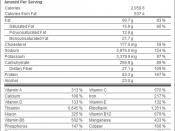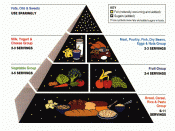This research paper is bascically about Nutrition and how to apply it to your daily life. Background information about da the food pyramid as well as statitics about American Health.
Good nutrition is vital to good health and is absolutely essential for the healthy growth and development of children and adolescents. Major causes of morbidity and mortality in the United States are related to poor diet and a sedentary lifestyle. Specific diseases and conditions linked to poor diet include cardiovascular disease, hypertension, dyslipidemia, type 2 diabetes, overweight and obesity, osteoporosis, constipation, diverticular disease, iron deficiency anemia, oral disease, malnutrition, and some cancers. Lack of physical activity has been associated with cardiovascular disease, hypertension, overweight and obesity, osteoporosis, diabetes, and certain cancers. Furthermore, muscle strengthening and improving balance can reduce falls and increase functional status among older adults. Together with physical activity, a high-quality diet that does not provide excess calories should enhance the health of most individuals.
Poor diet and physical inactivity, resulting in an energy imbalance (more calories consumed than expended), are the most important factors contributing to the increase in overweight and obesity in this country. Moreover, overweight and obesity are major risk factors for certain chronic diseases such as diabetes. In 1999-2002, 65 percent of U.S. adults were overweight, an increase from 56 percent in 1988-1994. Data from 1999-2002 also showed that 30 percent of adults were obese, an increase from 23 percent in an earlier survey. Dramatic increases in the prevalence of overweight have occurred in children and adolescents of both sexes, with approximately 16 percent of children and adolescents aged 6 to 19 years considered to be overweight (1999-2002). In order to reverse this trend, many Americans need to consume fewer calories, be more active, and make wiser choices within and among food groups.
Nutrient needs should be met primarily through consuming foods. Foods provide an array of nutrients and other compounds that may have beneficial effects on health. In certain cases, fortified foods and dietary supplements may be useful sources of one or more nutrients that otherwise might be consumed in less than recommended amounts. However, dietary supplements, while recommended in some cases, cannot replace a healthful diet. It is important to incorporate the food preferences of different racial/ethnic groups, vegetarians, and other groups when planning diets and developing educational programs and materials.
The first step in planning a healthy diet to examine what you eat. After analyzing your current diet you should compare it with your optimal dietary goals. Next, experiment with additions and substitutions to your current diet to bring it closer to your goals. If you need to plan your diet from ground up, use the Food Guide Pyramid and the Dietary Guidelines. The last and most important step is to put your plan in action and staying committed to it. Once you start taking small steps it will be easier to change your eating habits in the long run. Knowledge of food and nutrition is essential to the success of your program. It gives you the tools you need to design and implement a diet that promotes long-term health and well-being.
The type and amount of food you eat has a major effect on your diet. The following are food groups and recommendations for calorie intake to help you plan your diet.
FOOD GROUPS TO ENCOURAGE
Key Recommendations: Consume a sufficient amount of fruits and vegetables while staying within energy needs. Two cups of fruit and 21/2 cups of vegetables per day are recommended for a reference 2,000-calorie intake, with higher or lower amounts depending on the calorie level.
Choose a variety of fruits and vegetables each day. In particular, select from all five vegetable subgroups (dark green, orange, legumes, starchy vegetables, and other vegetables) several times a week.
Consume 3 or more ounce-equivalents of whole-grain products per day, with the rest of the recommended grains coming from enriched or whole-grain products. In general, at least half the grains should come from whole grains.
Consume 3 cups per day of fat-free or low-fat milk or equivalent milk products.
FATS
Key Recommendations: Consume less than 10 percent of calories from saturated fatty acids and less than 300 mg/day of cholesterol, and keep trans fatty acid consumption as low as possible.
Keep total fat intake between 20 to 35 percent of calories, with most fats coming from sources of polyunsaturated and monounsaturated fatty acids, such as fish, nuts, and vegetable oils.
When selecting and preparing meat, poultry, dry beans, and milk or milk products, make choices that are lean, low-fat, or fat-free.
Limit intake of fats and oils high in saturated and/or trans fatty acids, and choose products low in such fats and oils.
CARBOHYDRATES
Key Recommendations: Choose fiber-rich fruits, vegetables, and whole grains often.
Choose and prepare foods and beverages with little added sugars or caloric sweeteners, such as amounts suggested by the USDA Food Guide and the DASH Eating Plan.
Reduce the incidence of dental caries by practicing good oral hygiene and consuming sugar- and starch-containing foods and beverages less frequently.
SODIUM AND POTASSIUM
Key Recommendations: Consume less than 2,300 mg (approximately 1 tsp of salt) of sodium per day.
Choose and prepare foods with little salt. At the same time, consume potassium-rich foods, such as fruits and vegetables.
Before I did my research on nutrition, I didn't think it would be such an important part of our diet. However, after writing this paper I realize nutrition is one of the most important concepts in our daily diet. I learned a lot from reading health articles and visiting nutrition websites. Now I know how important it is to eat healthy and stay healthy. This assignment helped me develop my own plan to start eating the right type of food and to change my eating habits. I am planning to start my diet plan when this semester is over.
Reference:
http://www.nhlbi.nih.gov/health/public/heart/hbp/dash/.
http://www.usda.gov/cnpp/pyramid.html


